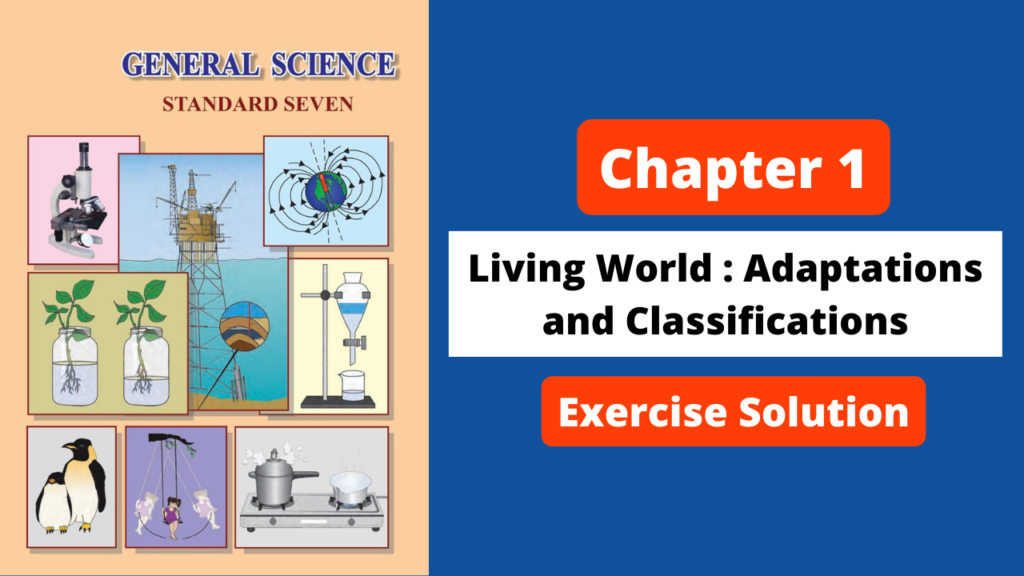1. Distinguish between the following.
a. Physical change and Chemical change
Answer:
| Physical changes | Chemical changes |
| 1. In a physical change material may change its | 1. A change which after physical properties and |
| shape, size, texture or state. | composition also. |
| 2. No new compound is formed. | 2. New compound /substance is formed due to chemical change. |
| 3. The change is temporary. It is reversible. | 3. The change is permanent and irreversible. |
| 4. Examples: Evaporation of water, boiling of water, melting of ice. | 4. Examples: Burning of wood, paper, souring of milk, digestion of food, rusting of iron. |
b. Periodic changes and Non-periodic change
Answer:
| Periodic changes | Non-periodic change |
| 1. Some changes occur again and again after a definite interval of time. Such changes are called periodic changes. | 1. In this, certain changes will recur after one occurrence, it cannot be said for sure, even if they occur interval is not fixed. Such changes are called non-periodic changes. |
| 2. Examples: movement of clock hands in clock showing time, change of season, day and night formation, heart beat, ripening of fruit, rising and setting of the sun. | 2. Examples: volcanic eruption, occurrence of an earthquake, tsunami, forest fires, freezing of water to form ice, sneezing, rusting of iron. |
| 3. They repeat themselves after a fixed interval of time. | 3. They do not repeat themselves after a fixed interval of time. |
c. Natural change and Man-made change
Answer:
| Natural change | Man-made change |
| 1. Changes that occur naturally on its own are called natural changes. | 1. Changes that are result of human activity. Such changes are called man-made. |
| 2. Examples ripening of a fruit, spoiling of milk, change in the climate | 2. Burning of fossil fuels, deforestation, pollution of air, water and soil. |
2. Under which different types can the following changes be classified?
a. Conversion of milk into yoghurt.
Answer:
Manmade (useful).
b. Bursting of cracker.
Answer:
Manmade (fast change).
c. Occurrence of an earthquake.
Answer:
Non-periodic.
d. Revolution of earth around the sun.
Answer:
Periodic. (Natural change)
e. Stretching of a spring.
Answer:
Physical, reversible change.
3. Give reasons.
a. While purchasing canned food, its expiry date should be checked.
Answer:
- Canned food is processed food.
- After certain period of time it may get spoilt due to some growth of micro-organism it may get intoxicated.
- If we consume such food we may get food poisoning, so we should check the expiry date.
b. An iron article should be given a coat of paint.
Answer:
- When an iron article is kept for long time it gets corroded due to presence of oxygen in atmosphere.
- Iron gets oxidized to iron oxide which forms a reddish brown layer on it and iron gets rusted.
- It is called corrosion. Due to corrosion things become weak.
- So an iron article should be given a coat of paint so that it is protected against corrosion.
- Paint gives protection to iron.
c. A Wooden article should be polished.
Answer:
- When a wooden article comes in contact with moisture there is possibility of fungal growth and also termites will make wooden article brittle and break.
- So a wooden article should be polished which forms a protective layer.
- It does not allow the wooden article to get decayed by moisture or attacked by termite.
d. Copper and brass utensils should be tinned.
Answer:
- Due to corrosion of copper or brass a greenish layer is seen to form on it.
- So to protect copper and brass utensils from corrosion they are coated with tin.
- This process is called thinning.
e. A dry handkerchief gets wet at once on dipping in water, but it takes long for a wet handkerchief to dry.
Answer:
- The dry fibres of handkerchief absorbs water to its maximum capacity immediately that is why handkerchief gets wet at once.
- When wet handkerchief dries, all the water absorbed has to become water vapour by evaporation.
- This depends on surrounding air and heat.
- That is why wet handkerchief takes a long time to dry.
4. What will you take into account while identifying the following:
a. A physical change in a substance.
Answer:
I will take into account the following facts.
- Whether the shape, size or state of the substance is changed.
- Whether it is a temporary change.
- Whether it is a reversible change.
b. A chemical change in a substance.
Answer:
I will take into account the following facts.
- Whether a new substance is formed.
- Whether it is a permanent change.
- Whether it is a non-reversible change.
5. Read the paragraph and note down the various types of changes it mentions.
It was nearing six o’clock in the evening. The sun was setting. A breeze was blowing. Leaves on the tree were shaking. Sahil was sitting in the courtyard, rolling balls of wet soil and shaping them into various toys. Then he felt hungry and went into the house. Mother made a dough from wheat flour and fried purees. While eating hot purees, his attention was drawn outside the window. It had started raining. There was lighting too. Sahil was enjoying his dinner in the dim light.
Answer:
- Clock showing six o’clock time – It is a periodic change.
- Sun was setting – A periodic change.
- Breeze was blowing – A natural change.
- Leaves shaking – A natural change.
- Making toys from wet soil – Physical change.
- Making dough from wheat flour – Physical change
- Frying purees – Chemical change.
- Raining – Natural change.
- Lightning – Natural change.



